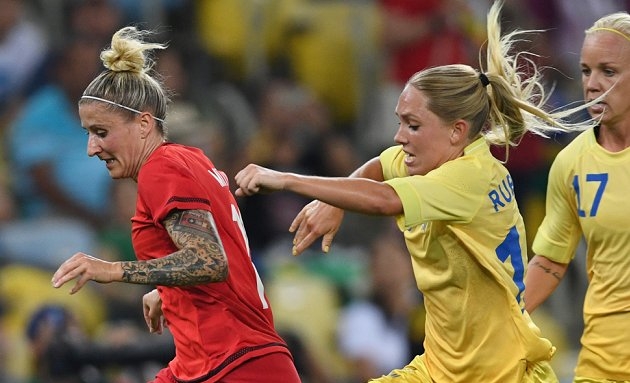After the intensity of the build-up in a Women's World Cup year, we had expected to see more literature on the women's game, and there have been a number of new books, though there is still room for more thoughtful writing on the game. So far this year, American midfielder Julie Ertz (Johnson) has authored a book while American women's soccer journalist Caitlin Murray explores the path of the U.S.'s triumph in the 2015 tournament in Canada in her book "The National Team—The Inside Story of the Women Who Changed Soccer." In addition, British soccer writer Gemma Clarke has written a book called Soccer Women—The Icons, Rebels, Stars and Trailblazers who Transformed the Beautiful Game, featuring a number of past and current players in the U.S., Europe and other regions around the world. Kieran Theivan (based in England.) and Jeff Kassouf (the founder of the excellent U.S.-based women's football site the Equalizer) have together written: The Making of the Women's World Cup: Defining Stories from a Sports Coming of Age. We will review Murray's, Clarke's and Theivan and Kassouf's books over the next few months.
Today, we review another new book: Futbolera—A History of Women & Sports in Latin America by Brenda Elsey and Joshua Nadel, published by University of Texas Press (2019). This book is a pure delight to read and provides tremendous new information on the struggles that the women's game has faced over the years throughout Central and South America. I thought one passage was particularly salient just after the 2019 Women's World Cup in France as the U.S. team members were talking about pay equity with the men's team and FIFA was doubling the payment of $30 Million in prize money this year to $60 Million in 2023, though doubling a number that is way too small to begin with—compared to over $400 Million for a men's World Cup payment pool—seems capricious and arbitrary. The authors wrote that in 1965: "An emergency committee of the International Federation of Association Football (FIFA) officially weighted in on women's football, recommending that federations 'adopt prudent reserve and …not encourage its development.'" (Page 124).
Futbolera is a fascinating read which delves in depth into the struggles that women athletes but particularly footballers have faced in Latin America, focused primarily on Argentina, Brazil, Chile and Uruguay in CONMEBOL and Mexico, Costa Rico and El Salvador in CONCACAF. The authors are both professors at U.S. universities. In the introduction, they discuss how there are areas when researching this topic that need more investigation; good research should always drive more scholarship and investigation. This work certainly does that and their mix of ethnographic interviews and exhaustive media sources is stunning. A lot of times, readers can be intimidated by academic works which they find as heavy slogging with tons of notes. There are lots of notes and citations at the end of the book—50 pages worth— but these can help drive future researchers in new investigations. But have no fear that this is a difficult read; the book is crafted quite well and reads easily; any women' soccer aficionados will be unable to put it down.
The book is divided into 5 chapters:
1 Physical Education and Women's Sports in Argentina and Chile
2 Policing Women's Sports in Brazil
3 Brazilian Sportswomen Defying Prohibition
4 Physical Education and Women's Sports in Mexico and Central America
5 The Boom and Bust of Mexican Women's Football
There is also a 20 page epilogue bringing the reader up to date on recent occurrences in the game in the region—that could easily have been expanded as it was quite interesting and salient, but the main focus of the book was on the early development of the sport over the past 100 years and that is handled quite well and with a wealth of detailed information.
Highlights include the book's in-depth look at the 1970 and 1971 World Championships held in Italy and Mexico respectively, while FIFA was dithering on as to whether they would oversee the women's game. I have written about these two tournaments in the past but the scope of information that the authors have found—including quotes from Mexican players who participated in both tournament—was extraordinary. Chapter 5 examines how in the early 70's, women's soccer in Mexico was burgeoning, in part due to the strong World Championship performance in which they finished second at home in 1971. At that point, women's sides in Mexico were growing at even a faster rate than in the U.S., with up to a 1,000 teams in 1971, while the Americans hadn't yet realized the impact of Title IX government legislation (established in 1972) which spurred the growth of the game in colleges and drove the youth explosion in the suburbs in the 1980's and 1990's and on into the new century. However, the Mexican Football Federation didn't encourage this growth and it fell off steeply and quickly.
The World Championship tournament in Mexico received attention throughout Latin America: "While both Chilean and Brazilian women were rumored to be organizing teams for the tournament, Argentina was the only South American delegation to compete in the 1971 world championship in Mexico. But where did the players come from? With scant coverage in the Argentine press, the mere existence of women's football might have come as a surprise. But from media reports as far afield as Spain and Mexico, it would appear that Argentina's largest clubs were the engines of a growth in women's football in the late 1960's and early 1970's. And there was some diffusion: a tournament between Universitario, Real Torino, Sporting and Rosario was aired on television to very high ratings." (Pages 55-56). Fifty years on, FIFA and CONMEBOL are trying to get major men's clubs in the region on board with supporting women's football—we will see if the Football Federation in Argentina can significantly impact the game and persuade big clubs to establish viable women's clubs over the next few years, leveraging the surprising and positive performance from their women's national team in France this summer.
In Brazil, in 1940 the focus was on women: "highlighting their health through beauty and physical education experts described beauty as an outward sign of eugenic health and feminine strength." Furthermore the authors' state: "The increased scrutiny of women's sexuality, morality and fertility led to more intense interest in their leisure activities. And those who saw women's football as detrimental to the well-being of the state found ready allies in the medical community to support their position." (Pages 96-97). Brazil's federal government ultimately created a law in 1941 to prevent women from playing for 38 years until it was repealed in 1979 but we find that the game did continue, particularly in states like Parana in the South, Minas Gerais (North of Sao Paulo) and Bahia (Northeast).
The game survived in Brazil during those 38 years also in part due to the circus. The fact that the circus routinely included small-sided women's soccer in their shows allowed it to skirt the ban: "In the early twentieth century, the line between respectable and disreputable leisure activities was not so sharply drawn as one might think. Circuses were one of the main places where 'high' and 'low' pastimes converged. A circus might feature a Shakespeare performance one night and 'exotic' human talents the next. As a space that often allowed for social transgression, it is perhaps unsurprising that it became one of the few places where women regularly played football. The circus featured novelty acts, to be sure, but women's football was not the only sport to use the relatively safe space as an incubator. Jujitsu and other emergent sports diffused through the circus, which could be as much a local festival as a spectacle of the bizarre. More established sports, such as men's football and particularly gymnastics, campaigned throughout Latin America to distinguish themselves from the circus. Members of physical education societies and authors of the somber guides to scientific exercise went to great lengths to demonstrate the difference between their techniques and those of circus performers. Women's football, on the other hand, because of its rareness in the early twentieth century, found a home or sorts within circuses." (Pages 73-74).
Futbolera has a strong focus on examining the role of physical education programs in public schools in these countries and how football was largely reserved for males, while swimming, volleyball, tennis, gymnastics and sometimes basketball were encouraged for women. Interesting nuggets included research on the development of a women's football players' union in Chile, and that Costa Rican clubs traveled throughout Central America in the 50's and helped to introduce and spread the sport from Panama through even to Mexico.
I have to say that this is one of the best books ever written on international women's football; it is quite well researched, with new and interesting revelations which show in part what the game has overcome but in some ways still needs to surpass to advance and grow, and not just in Latin America. I started reading it on my flight to France for the Women's World Cup, figuring that I would finish it on my flight home. It was so insightful and thought provoking that I finished reading it on the train after landing in Paris. To anyone that cares about the global women's game, this book is a necessity; it reminds us of where the game has come from, and how early successes—particularly in Mexico—were quickly undone through a lack of support and sometimes hostility. Supporters of the game cannot become complacent after such an artistic and financial success as we saw in France this summer—it's unlikely to happen but if we don't press for further support and development of the game, things could slide backwards. Futbolera shows us that, in the past in Latin America, progress can be undone far too quickly—a lesson we must not forget.
Tim Grainey is a contributor to Tribal Football. His latest book Beyond Bend it Like Beckham on the global game of women's football. Get your copy today.
Follow Tim on Twitter: @TimGrainey




























